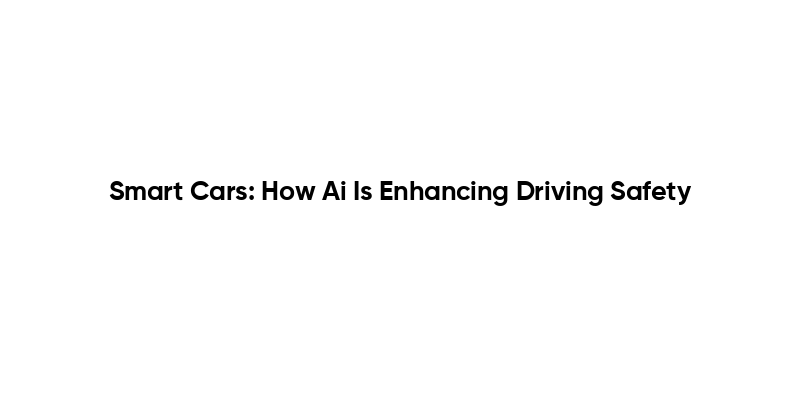In recent years, the automotive industry has witnessed a remarkable transformation with the advent of smart cars. These vehicles, equipped with advanced artificial intelligence (AI) technologies, are revolutionizing the way we think about driving safety. From adaptive cruise control to collision avoidance systems, AI is playing a pivotal role in enhancing the overall safety of our roads. In this article, we will delve into the various ways AI is integrated into smart cars, making them not only more efficient but also significantly safer for drivers and pedestrians alike.
As we explore the topic of “Smart Cars: How AI Is Enhancing Driving Safety,” you will learn about the cutting-edge technologies that are shaping the future of transportation. We will discuss the importance of real-time data analysis, machine learning algorithms, and sensor technologies that work together to prevent accidents and improve driver awareness. Additionally, we will highlight case studies of successful implementations of AI in vehicles, showcasing how these innovations are already making a difference on the roads.
Furthermore, we will examine the potential challenges and ethical considerations surrounding the use of AI in driving. As we navigate through this fascinating subject, you will gain insights into the future of smart cars and the role they will play in creating safer driving environments. Join us on this journey to discover how AI is not just a technological advancement but a crucial element in enhancing driving safety for everyone. Read on to uncover the exciting developments that lie ahead!
Advanced Driver Assistance Systems (ADAS)
Advanced Driver Assistance Systems (ADAS) are a crucial component of smart cars, utilizing AI to enhance driving safety. These systems include features such as adaptive cruise control, lane-keeping assistance, and automatic emergency braking. By leveraging sensors and cameras, ADAS can monitor the vehicle’s surroundings and provide real-time feedback to the driver, significantly reducing the risk of accidents.
Moreover, ADAS technologies are designed to assist drivers in making safer decisions. For instance, lane departure warnings alert drivers when they unintentionally drift out of their lane, while collision avoidance systems can automatically apply brakes to prevent potential crashes. As these systems continue to evolve, they are expected to play an even more significant role in reducing road fatalities and improving overall traffic safety.
Predictive Analytics for Accident Prevention
AI-driven predictive analytics is transforming how we approach accident prevention in smart cars. By analyzing vast amounts of data from various sources, including traffic patterns, weather conditions, and driver behavior, AI can identify potential hazards before they occur. This proactive approach allows for timely interventions, such as rerouting drivers away from congested or dangerous areas.
Additionally, predictive analytics can enhance vehicle maintenance by monitoring the health of critical components. For example, AI can predict when a tire is likely to fail based on usage patterns and environmental factors, prompting drivers to take preventive measures. This not only enhances safety but also extends the lifespan of the vehicle, making it a win-win for both drivers and manufacturers.
Real-Time Monitoring and Feedback
Real-time monitoring and feedback systems are integral to the safety features of smart cars. These systems utilize AI to continuously assess driving conditions and provide instant feedback to drivers. For example, if a driver is speeding or not maintaining a safe following distance, the system can issue alerts to encourage safer driving behavior.
Furthermore, these systems can also analyze driver fatigue and distraction levels. By employing facial recognition and eye-tracking technologies, AI can detect when a driver is becoming drowsy or inattentive, prompting them to take a break or refocus on the road. This capability is particularly important in preventing accidents caused by human error, which remains a leading cause of road incidents.
Vehicle-to-Everything (V2X) Communication
Vehicle-to-Everything (V2X) communication is a groundbreaking technology that enhances driving safety by enabling smart cars to communicate with each other and their environment. This includes interactions with traffic signals, pedestrians, and other vehicles, allowing for a more coordinated and safer driving experience. AI plays a vital role in processing and interpreting the data exchanged in V2X communication.
For instance, if a smart car receives a signal that a traffic light is about to change, it can adjust its speed accordingly, reducing the likelihood of running a red light. Additionally, V2X communication can help prevent accidents at intersections by alerting drivers to the presence of pedestrians or cyclists. As this technology becomes more widespread, it has the potential to significantly reduce traffic accidents and improve overall road safety.
The Future of Autonomous Vehicles
The future of autonomous vehicles is closely tied to advancements in AI and its application in enhancing driving safety. Fully autonomous cars are designed to operate without human intervention, relying on sophisticated AI algorithms to navigate complex driving environments. These vehicles utilize a combination of sensors, cameras, and machine learning to make real-time decisions that prioritize safety.
As autonomous technology continues to develop, it is expected to reduce human error, which is responsible for the majority of traffic accidents. Moreover, the integration of AI in autonomous vehicles allows for continuous learning from real-world driving scenarios, further improving their safety features over time. The transition to fully autonomous vehicles could revolutionize road safety, making transportation safer and more efficient for everyone.
| Aspect | Description |
|---|---|
| Introduction | Smart cars utilize artificial intelligence (AI) to improve driving safety through advanced technologies and systems. |
| Collision Avoidance | AI systems analyze data from sensors to detect potential collisions and automatically apply brakes or steer the vehicle to avoid accidents. |
| Adaptive Cruise Control | This feature uses AI to maintain a safe distance from the vehicle ahead, adjusting speed based on traffic conditions. |
| Lane Keeping Assistance | AI monitors lane markings and helps keep the vehicle centered in its lane, reducing the risk of drifting and accidents. |
| Driver Monitoring | AI systems can detect driver fatigue or distraction through facial recognition and alert the driver to take necessary actions. |
| Predictive Maintenance | AI analyzes vehicle data to predict maintenance needs, helping to prevent breakdowns and ensuring the vehicle operates safely. |
| Data Sharing | Smart cars can share data with other vehicles and infrastructure, enhancing situational awareness and improving overall road safety. |
| Conclusion | AI technologies in smart cars significantly enhance driving safety by reducing human error, improving vehicle responsiveness, and promoting safer driving behaviors. |



